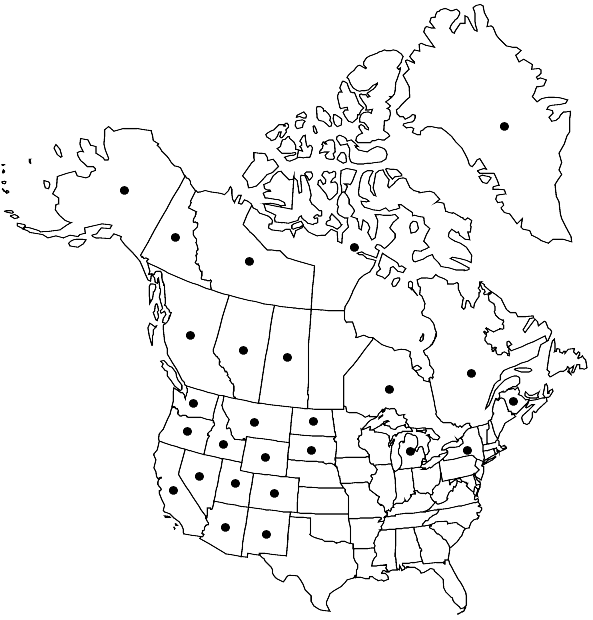Grimmia anodon
Bryol. Europ. 3: 110. 1845,.
Plants in small cushions, dark green to brown. Stems 0.5–1 cm. Leaves oblong-ovate to oblong-lanceolate, 0.9–2 × 0.4–0.8 mm, concave-keeled, awn 0.1–1.2 mm; basal juxtacostal laminal cells quadrate to long-rectangular, straight, thin-walled; basal marginal laminal cells quadrate to long-rectangular, straight, thin-walled; medial laminal cells quadrate, sinuose, thick-walled; distal laminal cells 1-stratose with 2-stratose patches, marginal cells 2-stratose. Sexual condition gonioautoicous. Seta sigmoid, 0.2–0.3 mm. Capsule usually present, exothecial cells thin-walled, annulus of 1–2 rows of quadrate, thin-walled cells, not revoluble, operculum mammillate, peristome absent.
Habitat: Exposed, calcareous sandstone, limestone, and concrete
Elevation: low to high elevations (20-2700 m)
Distribution

Greenland, Alta., B.C., N.B., N.W.T., Nunavut, Ont., Que., Sask., Yukon, Alaska, Ariz., Calif., Colo., Idaho, Mich., Mont., Nev., N.Mex., N.Y., N.Dak., Oreg., S.Dak., Utah, Wash., Wyo., ne Mexico, South America (Bolivia, Chile), Eurasia, Africa (Morocco).
Discussion
Grimmia anodon is widespread and common across the western United States and the mountains of southern Alberta and British Columbia. It is absent from eastern North America except around the Great Lakes and individual sites in the Gaspé Peninsula and New Brunswick. It extends sparsely into the Yukon and Alaska. These high latitude sites are strongly correlated with glacial refugia or areas of early deglaciation. Most eastern United States collecting localities are near the margin of the Wisconsinan continental ice sheet. The west-east disjunction of the species suggests the disruption of a more continuous distribution by Wisconsinan glacial events. It is widespread elsewhere in the northern hemisphere on calcareous outcrops and disturbed sites. Usually fertile, G. anodon is recognized easily by its immersed, gymnostomous capsule, on a sigmoid seta. The other widespread species in the subgenus, G. plagiopodia, has peristome teeth. When sterile these species can be difficult to differentiate, but G. anodon has leaves that are more keeled with 2-stratose margins, while leaves of G. plagiopodia tend to be more concave and are more uniformly 1-stratose. Grimmia anodon is rather similar to Schistidium flaccidum. However, the latter is characterized by a short, straight seta, leaves sharply keeled distally, and leaf margins plane at base but recurved distally on both sides.
Selected References
None.